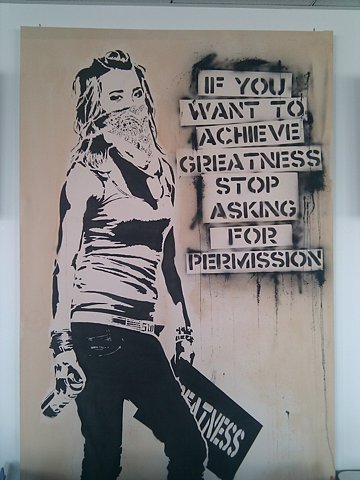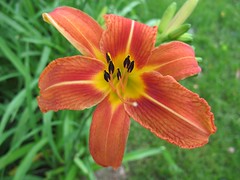
Sometimes the image says it all. And then some… “If you want to achieve greatness, stop asking permission.”

Sometimes the image says it all. And then some… “If you want to achieve greatness, stop asking permission.”
More nuggets of wisdom from Debbie Stier.
The moral of the story is to think differently. Really differently. Forget the old way. It doesn’t work in the new economy. Stop trying to control; make something useful and help people use it; get out of the way. Re-imagine the future.
If you’re not too sick and tired of the soap boxing, prognosticating and Doomsday ranting about the future of the publishing industry, Debbie Stier is a good level head to follow. She gets it. Goodbye, Gutenberg paradigm. Hello, Socratic paradigm. But she’s not sensational, nor does she submit her readers to the histrionics proliferating lately. It’s simple: create value, share, yield control and stand clear!

Winter Sunrise, Sierra Nevada from Lone Pine, Calif., 1944.
Photograph by Ansel Adams (Credit: Shelburne Museum)
The Shelburne Museum goes modern! Again. No, not more motorcycles… The museum’s fist modern and contemporary photography exhibition, Ansel Adams and Edward Burtynsky: Constructed Landscapes, opened on June 19 and runs until October 24. I haven’t had the chance to see it yet, but I’m hoping to within the next couple of weeks. Here’s the skinny:
Constructed Landscapes… features over 60 photographs by Ansel Adams (1902-1984), one of the most influential and popular landscape photographers in history and Edward Burtynsky (b. 1955), a contemporary photographer whose images of “manufactured landscapes” such as mines, railway cuts and dams have brought him considerable acclaim in the past decade. The exhibit explores concepts of the natural world, wilderness and how carefully crafted images can lead the viewer to specific conclusions and ultimately shape public perception about land use, natural resources and beauty. Burtynsky and Adams are in stark juxtaposition in Constructed Landscapes. Ansel Adams’ classic and pristine black and white images of undisturbed nature contrast with Burtynsky’s stunning color prints of landscapes altered by man, including quarries in Vermont.
Almost twenty years ago I studied photography in Washington, DC with a protege of Ansel Adams. I’m not sure how much I learned, but I loved the course, and it certainly was impressive to hear that our teacher had apprenticed with and developed for the master. For a couple of years I was fascinated with B&W photography, and gobbled up opportunities to idle afternoons away in a darkroom. Do younger readers even understand that experience? I’m a huge fan of digital photography, but I do miss the magical mood, lighting, sounds and smells of a dark room. Perhaps I’ll feel the twinge of nostalgia while enjoying the exhibition at the Shelburne Museum…
Related:
Click on the image for Kris Krug‘s digital story (yesmagazine.org)
Eleven weeks into the oil disaster that is devastating the Gulf Coast, hope can be hard to find. For photographer Kris Krug, capturing the horrifying impact of our dependence on oil is “my chance to take a little bit of my power back.” To those who feel emotionally overwhelmed by the disaster, Krug advises: “Do something. Action is the antidote to that despair you’re feeling.”(yesmagazine.org)
Photographically, psychologically and philosophically engaging, Kris Krug’s digital story about the aftermath of the BP oil spill fiasco offers a glimmer of hope. He acknowledges the weight that he’s felt in the months since BP’s well began pumping millions of gallons of crude oil into the Gulf of Mexico. But he also encourages us to act, to overcome the despair by engaging intelectuallay or artistically even if we can’t participate physically in ameliorating the disaster.

Lately the blogosphere is busy dissecting the merits and demerits of self-publishing. Though diverse concerns and hopes abound, the economics of self-publishing is a popular point of debate. Can authors earn a living by self-publishing?
Frankly, it’s still too early in this revolution to answer the question definitively. But as the economics of the publishing industry begin to shift rapidly and radically as they’ve already done in the music business, writers, agents and publishers need to study the financial viability of their occupations. On Thursday author Joe Konrath posted, “How to Make Money on eBooks” offering advice to writers in our post-Gutenberg era. His seven recommendations and Q&A are not groundbreaking news perhaps, but they are straightforward, important and timely for authors (and agents and publishers!)
I’m going with numbers one and seven as the most obvious but most important reminders. And I’m learning that platform, platform, platform (above and beyond deciding on whether you want to publish your digital book with Kindle or iBookstore…) is rapidly becoming the Holy Grail of the publishing world. So number eight, or maybe seven point five, should be build, improve, expand, support, and LOVE your platform.
Konrath’s Q&A section covers critical territory about agents and the pros and cons of traditional versus self publishing, and he circles around to the question on everyone’s mind: Can authors earn a living by self-publishing?
“I don’t know many people who make a living being traditionally published. Most of my peers have day jobs.That said, I’m making a living self publishing. I’m sure others can and will. But whether you can or not involves a lot of factors, some within your control, some not. But, in my humble opinion, a dedicated writer who turns out good material on a consistent basis will be able to, on average, earn more money self publishing than traditional publishing. I say this having done both.”
This might be the most hopeful publishing industry perspective in months!Read the full post here…
Related:
Random thoughts and observations, including photographs, in the tradition of a flaneur*: a stroller, a loiterer, a dawdler on street corners, a hanger-about who rambles through a city without any apparent purpose but is highly attuned to the history of the place and is in a constant covert search of adventure, esthetic or the exotic and erotic.
The hardest part of re-shingling Rosslyn dock house is now behind us. Special thanks to Michael Leslie, Jerry Spooner and Jim Spooner for their progress so far.
In a bizarre twist, David Hislop asked me yesterday, “What’s the story with the dock house?” Hmmm… The story? Well, that’s what I’m writing: Rosslyn Redux. Coming soon to a digital download near you. ;-) Turns out he was referring to the roof. “People are asking why you’re re-roofing it AGAIN.” Again? Apparently a half dozen people have asked him this question. Easy answer. We’re not. It hasn’t been re-shingled since the early/mid 1980’s, but after a quarter century of rain, snow, ice, sun and wind, many of the shingles have rotted through and the roof is leaking, especially the southern exposure. We’d known that we would eventually have to strip the old shingles, but we had delayed as long as practical. Let’s hope the new roof lasts as long as the old one!
I think of day lilies being a 4th of July flower, though they usually bloom for long after as well. This year, we’ve had day lilies in bloom for several weeks already!

Orange day lily
Originally uploaded by virtualDavis